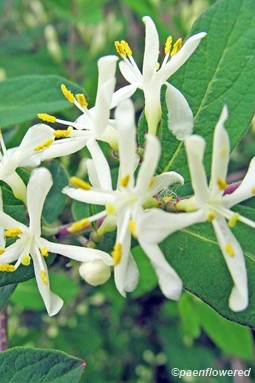Lonicera morrowii
Lonicera morrowii Morrow's honeysuckle
This flowering shrub is a species that was imported from central and eastern Asia as an ornamental plant. The flowers are fragrant and attractive. This species, however, has widely escaped cultivation and has become an aggressive invasive species, growing on the edges of woods, along roads and on stream banks. It is almost impossible to eliminate once established. The shrub can grow 6-10 feet tall and be 10 feet across and has numerous branches. The leaves are 2-3 ½ inches long and 1-1 ½ inches wide. The tips of the leaves are usually rounded. This is the easiest way to tell this species from the related amur honeysuckle (L. maackii) that has tapering, pointed-tipped leaves.
Flowers develop in pairs from the axils of the leaves in April or early May. Each flower is about ¾ to 1 inch long, has a tubular form with five widely spreading lobes. Initially, the flowers are white, but they become cream-colored as they age. The upper lip of the flower tube has 4 narrow lobes that are fused together, with the lower lip consisting of a single narrow lobe. There are five stamens with yellow anthers and a single style with a knobby green stigma that extends from the flower. They bloom over a period of about 3 weeks in late spring. Later shiny red, juicy berries replace the flowers, each containing 2-3 seeds. The fruit is poisonous to humans but is eaten by several types of wild birds.
The shrub spreads rapidly to new areas by reseeding. This and the amur honeysuckle have become so common that, in places, it has displaced native shrubs and, because it has leaves that emerge early, has shaded out native wildflowers and tree saplings. It is common at forest edges, but may also grow in mature forests. When abundant it may be the only plant species growing in some areas. Often they will grow over guardrails and obscure highway visibility. On the slightly positive side it has become an important source of nectar for honeybees and hummingbirds and some songbirds eat the berries. A number of bird species also nest inside the shrub. Deer sometimes feed on the leaves and twigs. A red dye found in the berries has been shown to change the color of the feathers of the cedar waxwing to an unusual orange color.
Habitat & Range
Naturalized weed of disturbed woods, old fields, floodplains, and roadsides.
Present throughout the state.
| EMP: | FACU |
|---|---|
| NCNE: | FACU |
Phenology
Flowers in May.
Fruits in late June through July.


.jpg?v=638120063270000000)







Comments
Have you spotted this plant in your area? We'd love to hear about your experience! Share your comments or questions about the plant below. Comments are moderated before posting.